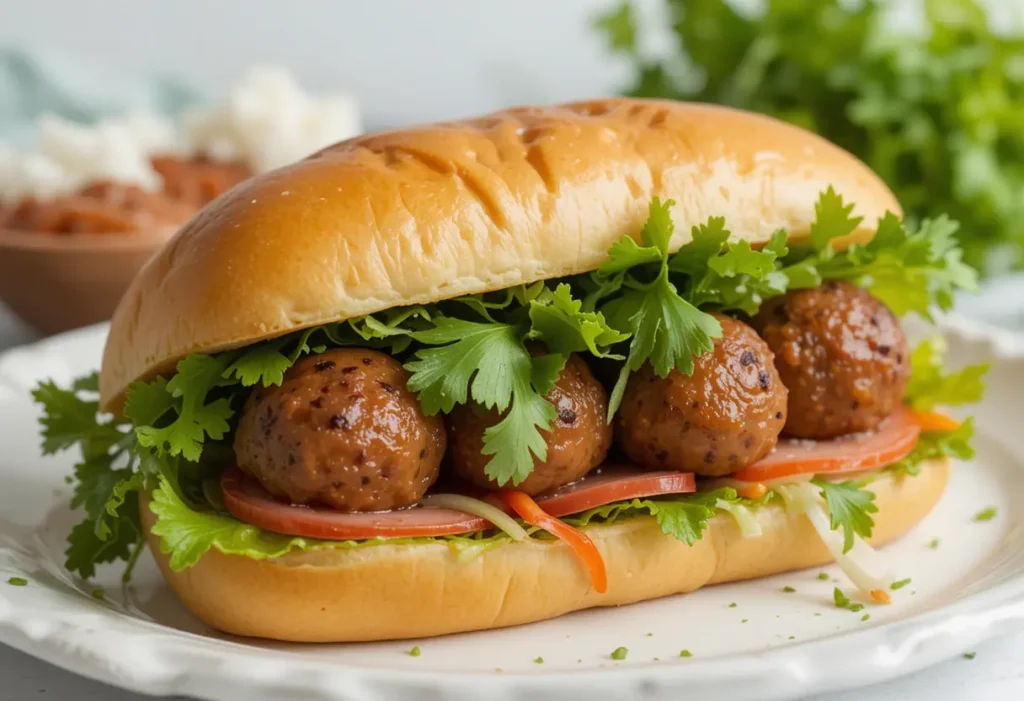pork meatballs (Xíu Mại)
When you think of siu mai, your mind might immediately jump to the classic Chinese dumplings served at dim sum. However, Vietnam’s version, xíu mại, offers a unique reinterpretation. Instead of dumplings, xíu mại is made into flavorful meatballs, typically cooked in a sweet and tangy tomato-based sauce. This Vietnamese dish showcases the country’s remarkable ability to take inspiration from other cuisines and make it its own.
pork meatballs has become a beloved part of Vietnamese street food and home-cooked meals. It is typically paired with a crusty baguette (bánh mì) or served over rice, making it versatile and satisfying. To get started with making this dish, check out the Vietnamese Meatballs Recipe.
What is Xíu Mại?
The term xíu mại derives from the Chinese word “shumai” (燒賣), which traditionally refers to a steamed dumpling filled with pork or shrimp. In Vietnam, however, this concept evolves into something entirely unique. Vietnamese pork meatballs are tender pork meatballs simmered in a tomato-based sauce rather than being wrapped in dough.
How Is Xíu Mại Different from Chinese Shumai?
The main distinction lies in the preparation and serving styles:
- Texture: Chinese shumai is a dumpling with a soft wrapper, while Vietnamese xíu mại are meatballs.
- Flavors: While shumai relies on light soy-based seasoning, pork meatballs highlights bold Vietnamese flavors like fish sauce and tomatoes.
- Serving style: Vietnamese xíu mại is served as part of a meal, often with baguettes or rice, whereas shumai is a bite-sized appetizer.
For more Vietnamese culinary adaptations, visit Why Are Vietnamese Meatballs Chewy?.
The Historical Evolution of Xíu Mại
The origins of xíu mại can be traced back to Chinese immigrants who introduced shumai to Vietnam. Over the years, Vietnamese cooks adapted the dish, replacing the dumpling wrapper with meatball forms and infusing them with local ingredients like fish sauce (nước mắm) and jicama.
This transformation mirrors the broader influence of Chinese culinary traditions on Vietnamese cuisine. Dishes like bánh bao (steamed buns) and hủ tiếu (rice noodle soup) are other examples of how Vietnam has localized Chinese food into something distinctively Vietnamese.

What Makes Vietnamese pork meatballs Unique?
Core Ingredients
The secret to the rich flavors of xíu mại lies in its carefully selected ingredients:
- Ground Pork: The primary protein, often combined with shrimp for added texture.
- Vegetables: Jicama or water chestnuts are commonly added for crunch and moisture.
- Seasonings: Fish sauce, garlic, black pepper, and sugar create a harmonious blend of sweet and savory.
- Tomato Sauce: A tangy blend of tomatoes, sugar, and spices forms the base of the dish.
Preparation Methods
Unlike Chinese shumai, which are steamed, xíu mại is cooked in a tomato-based sauce. Common methods include:
- Steaming or Frying: Meatballs are steamed or lightly pan-fried to lock in flavor.
- Simmering in Sauce: After cooking, the meatballs are simmered in the tomato sauce until tender.
- Serving Style: The dish is often served hot, accompanied by crusty baguettes or rice.
For additional tips on creating the perfect pork meatballs, explore What Are Vietnamese Meatballs Made Of?.
How to Serve Xíu Mại
Traditional Serving Styles
The beauty of xíu mại lies in its versatility. Here are some popular ways to enjoy this dish:
- With Baguettes (bánh mì):
- Often enjoyed as a breakfast or snack.
- The baguette soaks up the tangy tomato sauce, creating a satisfying flavor combination.
- Frequently served with fresh herbs and pickled vegetables.
- Over Rice:
- pork meatballs becomes a hearty meal when paired with steamed white rice.
- The tomato sauce acts as a savory gravy, making each bite rich and flavorful.
- As a Standalone Dish:
- Served as an appetizer or a side dish.
- Often garnished with fresh cilantro and paired with dipping sauces.
Modern Twists
While traditional serving styles remain popular, chefs have also begun incorporating xíu mại into contemporary dishes:
- Pasta dishes, where the meatballs replace traditional Italian varieties.
- Sliders and sandwiches, offering a fusion of Vietnamese and Western cuisines.
- Pizza toppings, combining the tangy sauce and savory meatballs for a unique flavor.
For more inspiration, check out similar comfort foods like the Mississippi Chicken Recipe.

Health Benefits of pork meatballs
Vietnamese pork meatballs is not only delicious but also offers some nutritional benefits:
- High in Protein: The pork and shrimp provide essential amino acids.
- Rich in Vitamins: The tomato sauce contains vitamin C and antioxidants.
- Customizable: Can be adapted to suit various dietary preferences, including low-carb or gluten-free options.
To make it healthier, opt for lean ground pork and reduce the sugar content in the sauce.
FAQs About Xíu Mại
What is pork meatballs in Vietnamese?
pork meatballs refers to Vietnamese-style pork meatballs cooked in a sweet and tangy tomato sauce.
Is Xíu Mại a Dumpling or a Meatball?
It’s a meatball dish. Unlike Chinese shumai, Vietnamese xíu mại doesn’t include a dumpling wrapper.
Can Xíu Mại Be Made Vegetarian?
Yes! Substitute the pork with tofu or plant-based proteins, and use soy sauce instead of fish sauce.
What’s the Best Way to Serve Xíu Mại?
The most popular way is with baguettes (bánh mì) or steamed rice, which complement the rich sauce perfectly.
Cultural Significance of Xíu Mại
Xíu mại is more than just a meal; it represents the ingenuity of Vietnamese cuisine. Born from Chinese culinary traditions, it has become an essential part of Vietnamese street food culture and home cooking. Its adaptability also highlights Vietnam’s openness to international influences while maintaining its unique identity.
Recipe Spotlight: Vietnamese Xíu Mại
If you’re ready to try your hand at making this dish, here’s a quick overview of what you’ll need:
- Ingredients:
- Ground pork (500g)
- Jicama (100g, finely chopped)
- Garlic (2 cloves, minced)
- Fish sauce (2 tablespoons)
- Tomatoes (3, pureed)
- Sugar, salt, and pepper to taste
- Instructions:
- Mix ground pork, jicama, garlic, and seasonings to form meatballs.
- Steam the meatballs for 10–15 minutes.
- Prepare the tomato sauce by simmering pureed tomatoes with sugar and fish sauce.
- Add the meatballs to the sauce and cook for an additional 10 minutes.
- Serve hot with baguettes or rice.
For detailed instructions, visit Vietnamese Meatballs Recipe.
Conclusion
Xíu mại is a dish that embodies the heart of Vietnamese cuisine. Whether paired with a warm baguette, served over rice, or enjoyed on its own, it delivers a comforting and flavorful experience. This dish is a testament to Vietnam’s ability to take culinary inspiration from other cultures and create something entirely its own.
Explore more Vietnamese recipes and discover how xíu mại fits into the broader context of the country’s rich culinary traditions. Let this be your next kitchen adventure!


1 thought on “What Is Xíu Mại in Vietnamese?”
Comments are closed.